The Sisters of Cootes Store
Steven David Johnson & Anna Maria Johnson
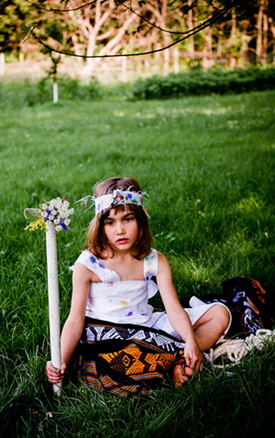
Magdalena and Eliza, our daughters, are untroubled by the mixture of natural and human-made materials in their environment. When Eliza was very small, perhaps two or three, she casually mentioned that fingernails were made of plastic. At nine, she now knows about keratin, but mixes real and artificial flowers into a bouquet without feeling a need to separate them. Likewise, her sister, Maggie, sees no inconsistency in crafting a “Queen of the Nature” costume that includes PVC pipe.
My husband, Steven, and I admire our daughters for their ability to navigate complex worlds—digital and analog, rural and urban, consumer-based and spiritual—often wonder-struck, yet at the same time, maintaining a critical distance that seems, to me, unexpected in children. The two of them strike a balance between engaging the world around them, and remaining separate from it. For instance, they discuss popular culture as they learn about it from their classmates’ clothing and conversation, without begging to own the things—Bratz doll, cell phone, BB gun—that “everyone” seems to have. Magdalena relates to the environment on her own terms—constructing clothing from rags and flowers, seeking out the forgotten corners of a cluttered kitchen, choosing to wear a bike helmet into the river.
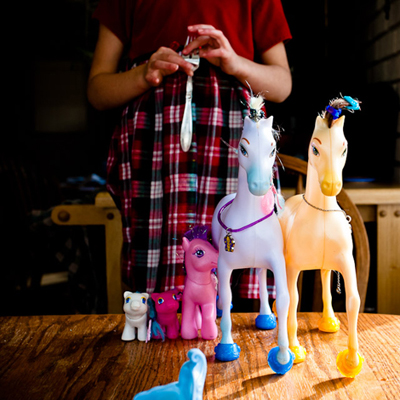

Five years ago, our family moved into a 110-year-old farmhouse on 2.3 acres in the Shenandoah Valley, overlooking the Shenandoah River’s North Fork. Once a log cabin, it has since been amended, clapboarded, vinyl-sided, and dry-walled into modern respectability, though plenty of lovable quirks remain—wood plank bedroom ceilings, steep stairs, foot-thick walls, hand-made plank doors with old-fashioned latches, secret closets. The bathroom, an aging plumber told us, was installed in the late 1960s or 70s; he remembers doing it.
We live in what used to be a little village called Cootes Store, which in the 1920s, had its own post office and general store, three-room schoolhouse and two churches. Almost a century later, our address is listed as “Broadway,” the name of the small town located three miles away, with its subdivisions, Dollar General, and sprawling, brick, consolidated schools where all the rural kids (including ours) get bussed. When the school year ends, our daughters turn to the Shenandoah.

Our daughters, through time spent in and around the river, carry with them a sense of its power as well as its vulnerability. After heavy rains, the ford on which the girls love to play and leap is submerged beneath the current. When the waters recede, they notice the cracked cement, the shifted rocks, a drowned tree. During last summer’s drought, however, the river became shallow enough for Magdalena to walk across, ankle-deep. Occasionally tires, rusted metal, plastic bags, and beer cans snag in the rocks and branches along the river’s edge. We must bathe after swimming to wash off the residue—filmy, with an algae smell—from agricultural run-off and busy Route 259. Eliza and Magdalena worry about the proposed hydraulic fracturing that would take place a few miles upstream from our home. They’re concerned that our well could become poisoned. The girls, offended that some people can be so careless, clean up any debris small enough for them to handle. But if it’s interesting, Magdalena will add it to her collection of things she’s found at the river—exoskeletons, skulls, small rusted objects, water-smoothed glass bits.
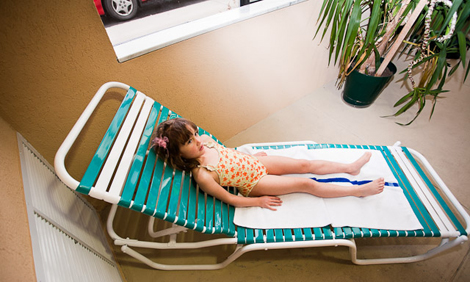
Steven has photographed our daughters since their births, not as a documentarian or a portraitist, but as someone who sees transcendent beauty in ordinary life. Influenced by artists such as Johannes Vermeer and Nicholas Poussin, Steven views his imagery more like paintings than photographs. He takes a formal approach to composition—carefully framing shapes, colors, motifs, the balance of positive and negative space.
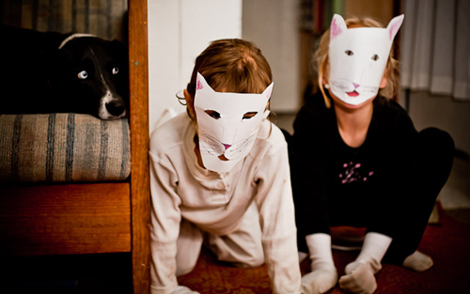
Because Steven so frequently has his camera, the girls and I barely notice its presence anymore. It’s like white noise. As a result, his photographs are able to reveal the children’s real lives and real behaviors, untainted by self-consciousness or artifice. Sometimes the girls and I don’t know the camera was present until days afterward, when we gather round the laptop screen to see Steven’s recent downloads. Other times, there’s more of a dance between photographer and subjects—a subtle collaboration.

The colors in “The Sisters” series draw attention to the contrast between the natural and human-made elements—earth tones, such as the greens and browns of woods and river, are paired against artificial colors like fluorescent pink and electric blue. Bright pinks—Eliza’s favorite color—link most of the photographs in the series: piñata, sticky note, witch hair, soap bubbles, plastic toy horse, fairy costume, dresses, balls, hair bow, and even the azalea, a flower native to Virginia. Meanwhile, Magdalena’s favorite color, blue, runs parallel, in toy horse’s hooves, clothing, flashes of light, bubbles, deck chair, bike helmet, and—naturally, eyes and sky.
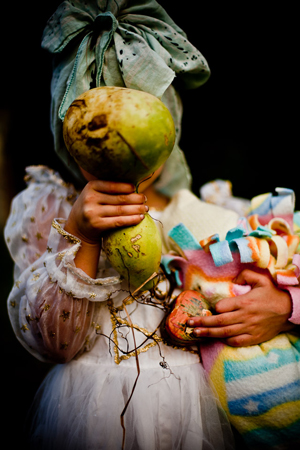
Stepping away, for a time, from the ordinary business of parenting and housekeeping in order to view our children through Steven’s artistic vision, my perception of our family is transformed. Life as seen through his lens is quieter, distilled. Life in the Shenandoah Valley—and these sisters—are beautiful, yes. But also made strange and mysterious. Viewing the images of this photo-series, I am reminded that although these small people, my daughters, came from my body, they are no longer part of me. They are inscrutably themselves, with their own thoughts, their own way of being and knowing.
 Steven David Johnson is a freelance photographer and a Visual and Communication Arts professor at Eastern Mennonite University. A featured artist in Ruminate Magazine and Rock & Sling, his photographs have also appeared in Orion, Shots, and National Geographic Traveler. He is married to artist and writer, Anna Maria Johnson, and lives with their two children in Cootes Store, Virginia. Visit him at www.stevendavidjohnson.com.
Steven David Johnson is a freelance photographer and a Visual and Communication Arts professor at Eastern Mennonite University. A featured artist in Ruminate Magazine and Rock & Sling, his photographs have also appeared in Orion, Shots, and National Geographic Traveler. He is married to artist and writer, Anna Maria Johnson, and lives with their two children in Cootes Store, Virginia. Visit him at www.stevendavidjohnson.com.
 Anna Maria Johnson is a candidate for an MFA in creative writing at Vermont College of Fine Arts, and a contributor to the blog Numéro Cinq. Her stories and essays have been published in Ruminate Magazine, The North Fork Journal, DreamSeeker Magazine, and The Mennonite. Anna Maria writes, gardens, and makes art along the Shenandoah River’s north fork with photographer Steven David Johnson, their two daughters, a cat, and a dog.
Anna Maria Johnson is a candidate for an MFA in creative writing at Vermont College of Fine Arts, and a contributor to the blog Numéro Cinq. Her stories and essays have been published in Ruminate Magazine, The North Fork Journal, DreamSeeker Magazine, and The Mennonite. Anna Maria writes, gardens, and makes art along the Shenandoah River’s north fork with photographer Steven David Johnson, their two daughters, a cat, and a dog.

Awesome collaboration, and I like the photos chosen for your bios, too.
Very nice Anna María this is a great way to commemorate your daughters, awesome.
Wonderful pictures and writing. Makes me think of spending time outdoors with my young son, who is just as likely to pick up and find interest in an old plastic wand for blowing bubbles as he is a ladybug, say. Well done…I hope there’s more!
Beautiful. Simply beautiful. Being able to step back and look at life from someone else’s perspective is a gift only few are blessed with. The simplicity of life is often lost in our days; this is a beautiful reminder to observe the life that surrounds each of us.
Thank you for your kind remarks.